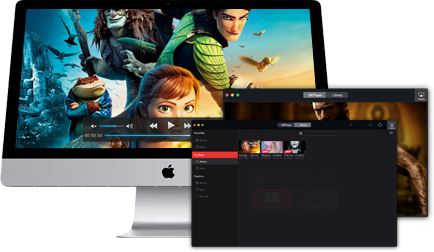

- #264 video file player how to
- #264 video file player mp4
- #264 video file player 32 bit
- #264 video file player windows
Which for H.264 means that you’ll never be able to create an 8K file out of one of these apps.
#264 video file player how to
At its highest level, Level 5.2, AVC/H.264 has a maximum frame size of 4,096 x 2,304 pixels 56 frames per second, or 4,096 x 2160 60 frames per second, so that standard H.264 decoders don’t have to accommodate any frame size or frame rate larger than that.Ĭommercial video encoders like those paired with the common NLEs Adobe Premiere, AVID Media Composer, and Final Cut Pro X, assume that you’ll want the broadest compatibility with the video file, so the software makes most of the decisions on how to compress the file, and strictly adheres to the available limits. For AVC/H264, the different sets of limits are called Levels. Standards like MPEG-4 Part 10, Advanced Video Coding (AVC) / ITU-T Recommendation H.264 (H.264) exist to allow different hardware and software manufacturers to exchange video files with the guarantee they’ll actually work on someone else’s system.īecause of this standards have to impose limits on things like frame size, frame rate for a given frame size, and data rate in bits per second. And for delivering VR video out of Google’s Jump VR system.Īnd since you’re probably now asking: “how do you cheat a standard?”, let’s review exactly what standards are. Just like Google does for 8K streaming on YouTube. So how did we do it? We cheated the standard. But once we did, we opened up the possibility of delivering files in any resolution to any client, regardless of the quality of their hardware.
#264 video file player mp4
Which is how we delivered the final files: AVC Video with AAC Audio in an MP4 container, at a resolution of 5,120 x 2880, though we ended up dropping the playback frame rate to only 30fps for better detail retention.įinding a way to encode and to play back these 5K files in H.264 wasn’t easy. The VP8 and VP9 scared the client, since they weren’t comfortable working with the Matroska video container (for reasons they never explained - quality wise, this was the best choice at the time), which left us with H.264. The HEVC was too computationally complex to be decoded in real time for 5K HFR, since there were no hardware decoders that could handle the format (even in 8 bit precision) and FFMPEG still needed optimizations to playback HEVC beyond 1080p60 in real-time, on almost every system.
#264 video file player 32 bit
Why not? The ProRes couldn’t be decoded fast enough by the 32 bit QuickTime player on Windows, and the DPX files had too high of a data rate to be read from anything but a SAN at the time.įortunately, we’d already been experimenting with encoding 5K files in a few different delivery formats: High Efficiency Video Coding (HEVC / H.265), VP8 and VP9, and Advanced Video Coding (AVC / H.264).
#264 video file player windows
We had no problem creating and playing 5K files on our systems, but when their team tried to play back the ProRes or DPX master files on their Windows based computer (which they were required to use for the presentation), they weren’t available to get real-time playback.



Since we’d been filming all of our videos at 5K resolution, remastering the files at their native camera resolution wasn't an issue and we were happy to work with them.īut as things moved forward with their marketing team we ran into a little problem. In 2014, a client asked about 5K, high frame rate footage to use on a demonstration display.


 0 kommentar(er)
0 kommentar(er)
